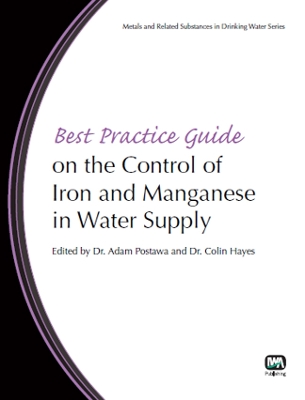Best Practice Guides on Metals and Related Substances in Drinking Water
2 total works
Optimisation of Corrosion Control for Lead in Drinking Water Using Computational Modelling Techniques
by Colin Hayes and T N Croft
Published 15 January 2013
In many respects, lead in drinking water has become a forgotten problem, since the mid 1980s when a range of environmental controls were implemented to reduce exposure to lead. This is largely because the sampling protocols, that underpin regulatory controls, are mostly inadequate and have tended to under-estimate the amount of lead that can be present in drinking water (IWA, 2010).
Optimisation of Corrosion Control for Lead in Drinking Water Using Computational Modelling Techniques shows how compliance modelling has been used to very good effect in the optimisation of plumbosolvency control in the United Kingdom, particularly in the optimisation of orthophosphate dosing. Over 100 water supply systems have been modelled, involving 30% of the UK's water companies. This "proof-of-concept" project has the overall objective of demonstrating that these modelling techniques could also be applicable to the circumstances of Canada and the United States, via three case studies.
This report is the first in the Research Report Series published by the IWA Specialist Group on Metals and Related Substances in Drinking Water.
Authors: Dr. C. R. Hayes and Dr. T. N. Croft Collaborators A. Campbell, City of Ottawa Water (CA) I. P. Douglas, City of Ottawa Water (CA) P. Gadoury, Providence Water (US) M. R. Schock, US Environmental Protection Agency (US)
Optimisation of Corrosion Control for Lead in Drinking Water Using Computational Modelling Techniques shows how compliance modelling has been used to very good effect in the optimisation of plumbosolvency control in the United Kingdom, particularly in the optimisation of orthophosphate dosing. Over 100 water supply systems have been modelled, involving 30% of the UK's water companies. This "proof-of-concept" project has the overall objective of demonstrating that these modelling techniques could also be applicable to the circumstances of Canada and the United States, via three case studies.
This report is the first in the Research Report Series published by the IWA Specialist Group on Metals and Related Substances in Drinking Water.
Authors: Dr. C. R. Hayes and Dr. T. N. Croft Collaborators A. Campbell, City of Ottawa Water (CA) I. P. Douglas, City of Ottawa Water (CA) P. Gadoury, Providence Water (US) M. R. Schock, US Environmental Protection Agency (US)
This Best Practice Guide on the Control of Iron and Manganese in Water Supply is one of a series produced by the International Water Association's Specialist Group on Metals and Related Substances in Drinking Water.
Iron and manganese are often found in soft upland water sources associated with natural organic matter and are also commonly found in the groundwater abstracted from confined and unconfined aquifers. The presence of iron and manganese in water is one of the most frequent reasons for customers' complaint due to aesthetic issues (yellow, brown and black or stains on laundry and plumbing fixtures). These two metals can be removed fairly readily by physico-chemical treatment. The municipal treatment systems deployed derive benefit from their larger scale, particularly in relation to control, but the processes used are less suitable for the numerous small supplies that are the most common water supplies throughout Europe, especially in rural areas. One important source of iron in drinking water is from old corroded cast-iron water mains, historically the material used most commonly in supply networks. Replacement and refurbishment is very expensive and the major challenge is how best to prioritize available expenditure.
The purpose for this Best Practice Guide on the Control of Iron and Manganese in Water Supply is to give readers the broad view of a problem based on state-of-the-art compilation of the range of scientific, engineering, regulatory and operational issues concerned with the control of iron and manganese in drinking water. The Guide is of interest to water utility practitioners, health agencies and policy makers, as well as students on civil engineering and environmental engineering courses.
Authors: Dr Adam Postawa, AGH University of Science and Technology, Faculty of Geology, Geophysics and Environment Protection, Krakow, Poland and Dr Colin R Hayes, University of Swansea, UK, Chair of IWA Specialist Group on Metals and Related Substances in Drinking Water.
Iron and manganese are often found in soft upland water sources associated with natural organic matter and are also commonly found in the groundwater abstracted from confined and unconfined aquifers. The presence of iron and manganese in water is one of the most frequent reasons for customers' complaint due to aesthetic issues (yellow, brown and black or stains on laundry and plumbing fixtures). These two metals can be removed fairly readily by physico-chemical treatment. The municipal treatment systems deployed derive benefit from their larger scale, particularly in relation to control, but the processes used are less suitable for the numerous small supplies that are the most common water supplies throughout Europe, especially in rural areas. One important source of iron in drinking water is from old corroded cast-iron water mains, historically the material used most commonly in supply networks. Replacement and refurbishment is very expensive and the major challenge is how best to prioritize available expenditure.
The purpose for this Best Practice Guide on the Control of Iron and Manganese in Water Supply is to give readers the broad view of a problem based on state-of-the-art compilation of the range of scientific, engineering, regulatory and operational issues concerned with the control of iron and manganese in drinking water. The Guide is of interest to water utility practitioners, health agencies and policy makers, as well as students on civil engineering and environmental engineering courses.
Authors: Dr Adam Postawa, AGH University of Science and Technology, Faculty of Geology, Geophysics and Environment Protection, Krakow, Poland and Dr Colin R Hayes, University of Swansea, UK, Chair of IWA Specialist Group on Metals and Related Substances in Drinking Water.

